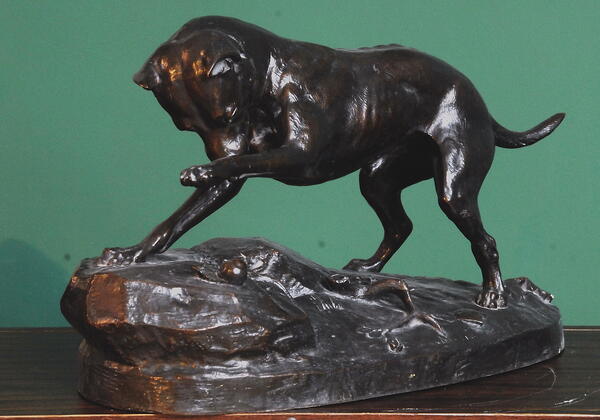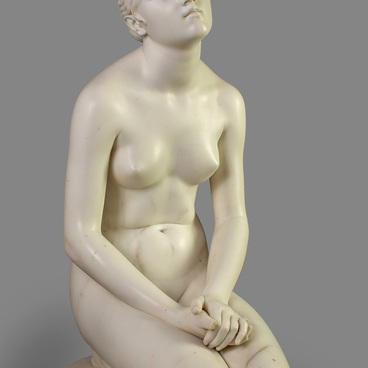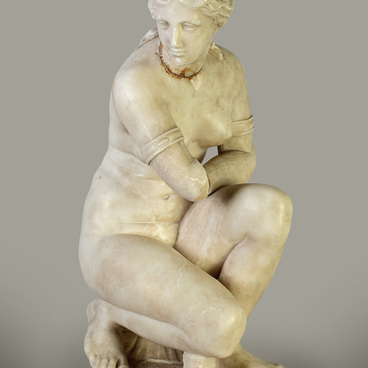The sculpture “Dog and Snail” from the Tambov Regional Art Gallery is attributed to the Belgian and French sculptor François Frédéric Steenackers based on the signature engraved on the plinth “ST…NACKERS 1877”. However, the experts of the Tambov Regional Museum of Local Lore believed that the statue was designed by the German sculptor Näckere. The museum’s inventory book also indicated that the statue was made in 1833. Later, Näckere was referred to as Näcker and the year 1877 was mentioned. However, this name could not be found in any of the reference books or dictionaries.
It is still unknown who made this statue even though its design is characterized by traits that are highly specific and undoubtedly typical of some authentic artist. This is also confirmed by the processing of the material, which is distinguished by contrasting the areas of light and shadow. It is also unclear where the statue came from. According to the records in the museum’s inventory book, in 1925, it belonged to a science museum. Later, based on the “List” by K. Tulupov (who drew up an inventory of the collection of Pavel Stroganov from the Znamensky estate in 1918), the museum researcher Yekaterina Salyakhova attributed the statue to the collection of Pavel Sergeyevich Stroganov. It entered the Tambov Regional Art Gallery in 1961.
The art expert Yekaterina Salyakhova studied the statue in 1986 and discovered that “Dog and Snail” resembled the works of the famous French animalier sculptor Antoine-Louis Barye (1796–1875), a representative of Romanticism in sculpture. After the statue was analyzed in more detail, and the signature was deciphered, it was attributed to François Frédéric Steenackers.
The composition consists of two figures: a dog attacking a snail. The sculptor skillfully portrayed them in a realistic manner, showing good knowledge of their character and anatomy. The dog’s head is slightly exaggerated in size and has a strongly pronounced tense forehead. The artist strove to demonstrate the animal’s powerful body and tense muscles. The viewer can observe the defined shapes of the dog’s muscles and skeleton. The design of the pedestal is also interesting. It seems to have a certain meaning, symbolizing the earth and nature — an image that is closely associated which the life of animals.
It is still unknown who made this statue even though its design is characterized by traits that are highly specific and undoubtedly typical of some authentic artist. This is also confirmed by the processing of the material, which is distinguished by contrasting the areas of light and shadow. It is also unclear where the statue came from. According to the records in the museum’s inventory book, in 1925, it belonged to a science museum. Later, based on the “List” by K. Tulupov (who drew up an inventory of the collection of Pavel Stroganov from the Znamensky estate in 1918), the museum researcher Yekaterina Salyakhova attributed the statue to the collection of Pavel Sergeyevich Stroganov. It entered the Tambov Regional Art Gallery in 1961.
The art expert Yekaterina Salyakhova studied the statue in 1986 and discovered that “Dog and Snail” resembled the works of the famous French animalier sculptor Antoine-Louis Barye (1796–1875), a representative of Romanticism in sculpture. After the statue was analyzed in more detail, and the signature was deciphered, it was attributed to François Frédéric Steenackers.
The composition consists of two figures: a dog attacking a snail. The sculptor skillfully portrayed them in a realistic manner, showing good knowledge of their character and anatomy. The dog’s head is slightly exaggerated in size and has a strongly pronounced tense forehead. The artist strove to demonstrate the animal’s powerful body and tense muscles. The viewer can observe the defined shapes of the dog’s muscles and skeleton. The design of the pedestal is also interesting. It seems to have a certain meaning, symbolizing the earth and nature — an image that is closely associated which the life of animals.





